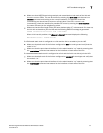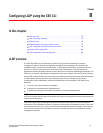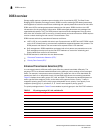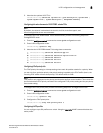
76 Dell Converged Enhanced Ethernet Administrator’s Guide
53-1002116-01
Layer 2 topology mapping
8
Layer 2 topology mapping
The LLDP protocol lets network management systems accurately discover and model Layer 2
network topologies. As LLDP devices transmit and receive advertisements, the devices store
information they discover about their neighbors. Advertisement data such as a neighbor's
management address, device type, and port identification is useful in determining what
neighboring devices are in the network.
NOTE
Dell’s LLDP implementation supports a one-to-one connection. Each interface has one and only one
neighbor.
The higher level management tools, such as Dell’s DCFM, can query the LLDP information to draw
Layer 2 physical topologies. The management tools can continue to query a neighboring device
through the device’s management address provided in the LLDP information exchange. As this
process is repeated, the complete Layer 2 topology is mapped.
In LLDP the link discovery is achieved through the exchange of link-level information between two
link partners. The link-level information is refreshed periodically to reflect any dynamic changes in
link-level parameters. The basic format for exchanging information in LLDP is in the form of a type,
length, value (TLV) field.
LLDP keeps a database for both local and remote configurations. The LLDP standard currently
supports three categories of TLVs. Dell’s LLDP implementation adds a proprietary Dell extension
TLV set. The four TLV sets are described as follows:
• Basic management TLV set. This set provides information to map the Layer 2 topology and
includes the following TLVs:
- Chassis ID TLV—Provides the ID for the switch or router where the port resides. This is a
mandatory TLV.
- Port description TLV—Provides a description of the port in an alphanumeric format. If the
LAN device supports RFC-2863, the port description TLV value equals the “ifDescr” object.
This is a mandatory TLV.
- System name TLV—Provides the system-assigned name in an alphanumeric format. If the
LAN device supports RFC-3418, the system name TLV value equals the “sysName” object.
This is an optional TLV.
- System description TLV—Provides a description of the network entity in an alphanumeric
format. This includes system name, hardware version, operating system, and supported
networking software. If the LAN device supports RFC-3418, the value equals the
“sysDescr” object. This is an optional TLV.
- System capabilities TLV—Indicates the primary functions of the device and whether these
functions are enabled in the device. The capabilities are indicated by two octets. The first
octet indicates Other, Repeater, Bridge, WLAN AP, Router, Telephone, DOCSIS cable device,
and Station, respectively. The second octet is reserved. This is an optional TLV.
- Management address TLV—Indicates the addresses of the local switch. Remote switches
can use this address to obtain information related to the local switch. This is an optional
TLV.
• IEEE 802.1 organizational TLV set. This set provides information to detect mismatched settings
between local and remote devices. A trap or event can be reported once a mismatch is
detected. This is an optional TLV. This set includes the following TLVs:


















